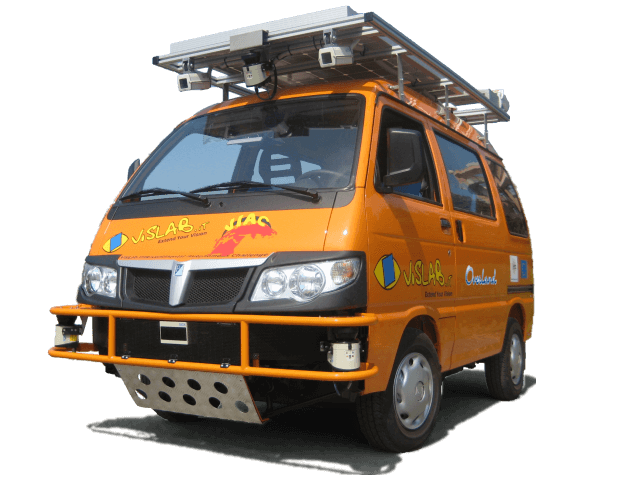Robot Vans Drive, Driverless, from Italy to China (Video)

Share
It’s the perfect sci-fi fantasy: climb into your car, set it to autopilot, then just lean back and enjoy your morning coffee as you’re whisked off to your destination. Driverless vehicles have come a long way since their inception in pulpy futuristic paperbacks – but most of them never make out of a closed testing course, and none of them try a cross-continental road trip in on regular roads with everyday traffic. Well, almost none.
The VisLab Intercontinental Autonomous Challenge is an epic autonomous road trip from Italy to China. Four (mostly) driverless vans are navigating the streets of Moscow, across Siberia and the Gobi Desert, and into Shanghai in time for the World Fair. The three-month, 8,000 mile venture is electric-powered, robot-steered, and a massive step forward for the field of autonomous driving technology. The team is halfway through their trip, and is currently in Eastern Europe.
The vans are each equipped with seven cameras and four laser scanners to construct an image of the surrounding road: where the lanes are, where other vehicles are, where pedestrians are. The on-board computer system combines this local sensory data with GPS tracking, waypoint following, and other navigation devices to allow the vans to travel unmanned – well, without anyone behind the wheel, anyway. Each van will include two human passengers to take over in case of emergencies.
Check out this EuroNews feature on the VisLab trip:
The navigation system isn’t perfect, partially because maps are unavailable for large portions of the route (e.g. Siberia). Because of this, the first robotic van – the leader vehicle – will operate autonomously for most (but not all) of the trip. Its human passengers will define its route and intervene occasionally in its operation. The leader van will then broadcast its GPS position to the follower van; this will allow the second van to operate 100% autonomously, combining GPS data with its onboard local sensors.
Each van is outfitted with solar panels along its roof, which power all the navigation systems and computers on board. The vans themselves are electric – they will power up at electric power stations along the route. For those long stretches without electric stations (e.g. again, Siberia) the team will use gas generators to recharge the vans’ batteries. In case one of the vans breaks down, there is a truck carrying alternate vehicles accompanying the trek.
Be Part of the Future
Sign up to receive top stories about groundbreaking technologies and visionary thinkers from SingularityHub.


There are lots of qualifiers to this trip – human intervention to direct pilotless vans, the gasoline generators to charge gasless engines, etc. Still, taking autonomous vehicles on a venture this far is a momentous accomplishment in itself. We’ve seen lots of awesome vehicular robotics designed for the DARPA Grand Challenge – e.g. Standford’s car that parks itself Ace Ventura style – and these are undoubtedly flashier and make for better Youtube videos. But VisLab is taking its road trip on real roads, not closed courses; it’s dealing with extreme weather in Siberia and the Gobi desert, not sunny California.
Plus, the point behind the VisLab trek isn’t just to show off their tech, but to improve it. All four vans will be recording their sensory and performance data for analysis. This huge dataset – expected to be about 100 terabytes – will help the team to further refine and improve their vehicles’ autonomy on the road. This cache of on-road data will include everything from weather to traffic performance, and will help the team fine-tune their systems’ algorithms. If and when the vans perform poorly, it’ll be a lesson learned.
VisLab has a blog where you can follow their progress, plus a webcam and live tracking of their position so you can watch along. The vans plan to roll into Shanghai by the end of October, in time to demo the system at the World Expo 2010.
The Intercontinental Autonomous Challenge was funded by a $2.3 million grant from the European Research Council.
[images courtesy of VisLab]
Drew Halley is a graduate student researcher in Anthropology and is part of the Social Science Matrix at UC Berkeley. He is a PhD candidate in biological anthropology at UC Berkeley studying the evolution of primate brain development. His undergraduate research looked at the genetics of neurotransmission, human sexuality, and flotation tank sensory deprivation at Penn State University. He also enjoys brewing beer, photography, public science education, and dungeness crab. Drew was recommended for the Science Envoy program by UC Berkeley anthropologist/neuroscientist Terrence Deacon.
Related Articles

These Robots Are the Size of Single Cells and Cost Just a Penny Apiece

In Wild Experiment, Surgeon Uses Robot to Remove Blood Clot in Brain 4,000 Miles Away

A Squishy New Robotic ‘Eye’ Automatically Focuses Like Our Own
What we’re reading

